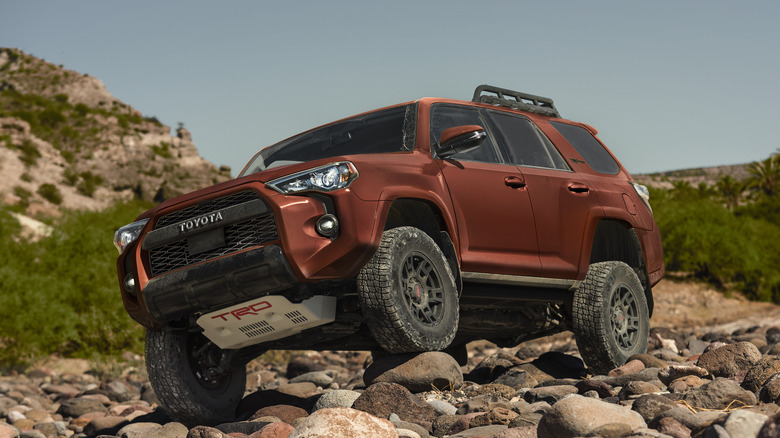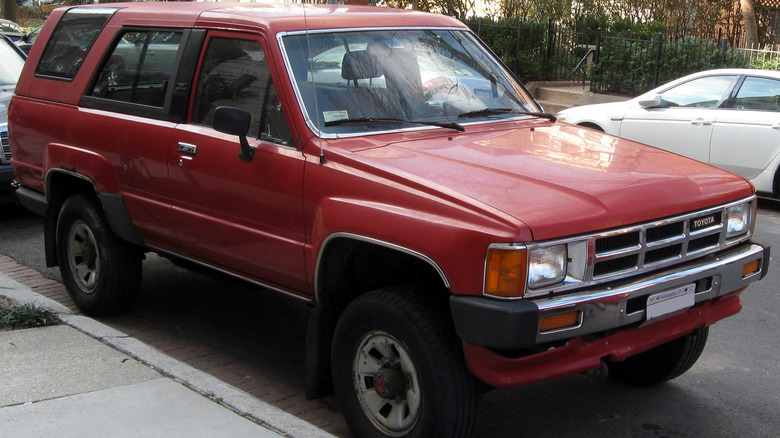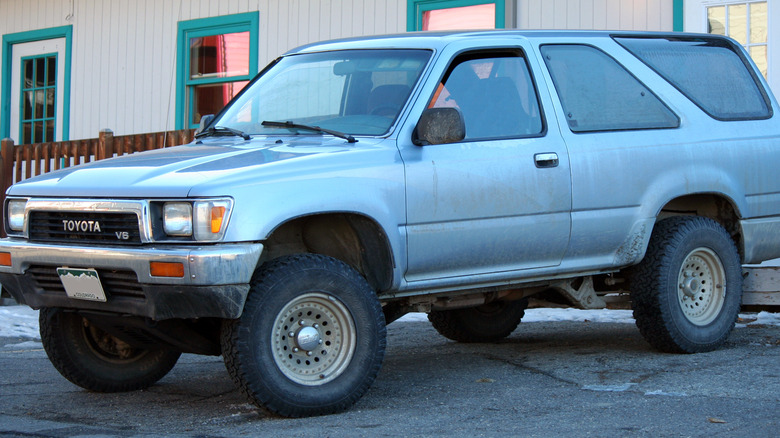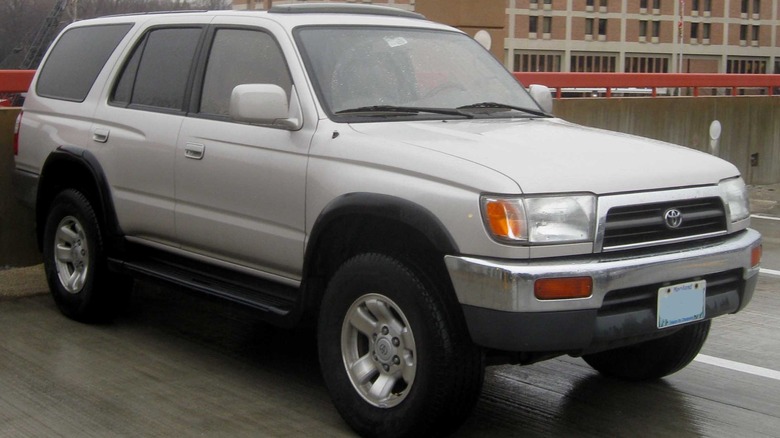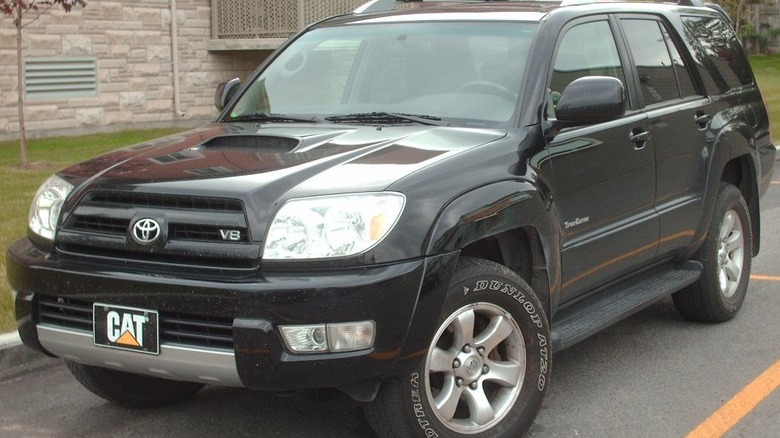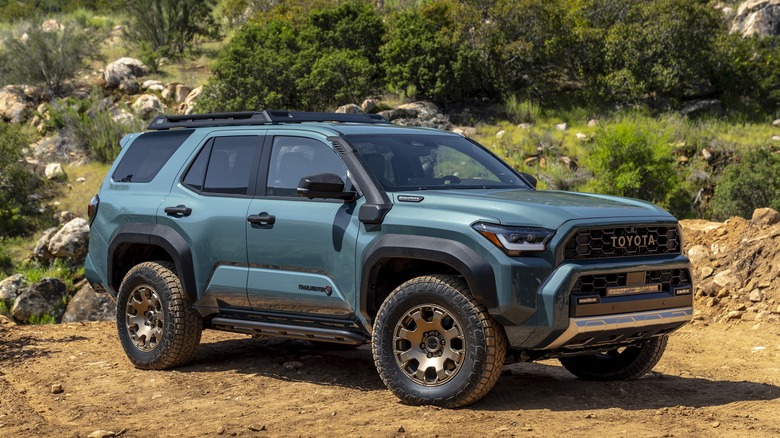5 Ways The Toyota 4Runner Has Changed Throughout The Years
Starting with the forthcoming 2025 model year, the Toyota 4Runner will be beginning its sixth generation. The SUV has had a four-decade production run that began with the 1984 model year, and it's undergone many changes in that time. It began as an evolution of the Toyota Trekker, a wagon version of the company's Hilux pickup truck. Since then, the 4Runner has built its own identity as one of the best-selling SUVs in the United States. Meanwhile, the Toyota Hilux hasn't been sold in the U.S. since the mid-1990s, having been replaced by the Toyota Tacoma.
The 4Runner has had lots of changes over the last 40 years covering basically every aspect of the vehicle. Even within individual generations, significant adjustments have been made. Let's look back through the life of the 4Runner and examine some of the differences — both big and small — between various model years for the SUV. These are some of the most notable ways in which the Toyota 4Runner has changed throughout the years.
The design changed from modified pickup truck to full SUV
As previously mentioned, the original Toyota 4Runner back in 1984 was built off the back of the Toyota Hilux — a compact pickup truck that the company had been making since the late 1960s. If you look at pictures of the original 4Runner, you can clearly see the pickup truck design and where it was modified to make it into an SUV. The roof extension that made it into an SUV was even a separate piece that could be removed. The second generation integrated the rear design of the 4Runner for a better flow from front to back, though the pickup structure was still fairly evident.
It wasn't until the third generation, which began with the 1996 model year, that the SUV fully divorced itself from the Hilux with an independent body and chassis. Design changes continued through the fourth and fifth generations, with the 4Runner becoming boxier in design over time. With the forthcoming 2025 model ushering in the sixth generation of the 4Runner, the design is changing again. The new look is a bit less boxy and a bit more rugged and sporty.
[Featured image by IFCAR via Wikimedia Commons | Cropped and scaled | Public Domain]
The 4Runner has gotten steadily larger over time
One of the main reasons that the Toyota 4Runner design has changed so much over the years is that the SUV has gotten bigger and bigger with time. As it was based on the Toyota Hilux, which was a compact pickup truck, the original 4Runner was a compact SUV. From end to end, it was 174.6 inches in length. It was also just a three-door SUV.
While the first-generation 4Runner had five seats across two rows, the importance of that back row wasn't enough to justify extending the cab to make it a five-door vehicle. It wasn't until the second generation in 1990 that Toyota decided to prioritize it as a five-door SUV, and by the time the 1996 model year arrived for the third generation, the three-door models had been completely discontinued. Plus, an optional third row began to be offered with the fourth generation, which saw some of the best 4Runner model years ever.
Naturally, this meant that the size of the 4Runner continued to increase. That original 174.6-inch length back in 1984 has steadily grown with every passing generation, with the most recent 2024 model measuring 190.2 inches. The upcoming sixth generation looks to make that even longer at 194.9 inches, averaging out to a half-inch increase every year of the 4Runner's lifespan.
[Featured image by Mr.choppers via Wikimedia Commons | Cropped and scaled | CC BY-SA 3.0]
4Runner engines have changed a lot too
As the 4Runner models have grown over the years, the same is true of the engines that power them. At the beginning of the 4Runner's life, all that was available in the United States was a 2.4L 22R I4 engine, but that was quickly replaced by the 22R-E the following year, which introduced electronic fuel injection to the SUV. One year later, a turbocharged version of the engine was made available, and one year after that, Toyota delivered its first V6 option for the 4Runner with a 3.0L 3VZ-E V6.
It wasn't until the third generation in 1996 that Toyota updated the engine options again. The standard issue engine was a 2.7L 3RZ-FE I4 with an option to upgrade to a 3.4L 5VZ-FE V6, which also came standard on some of the more expensive trims. The jump between generations three and four saw the biggest size increase for the 4Runner engines. Not only did the base displacement jump from 2.7L to 4.0L, but the V6 came standard rather than an I4, making a 4.7L V8 the new premium option. Toyota attempted to bring back the 2.7L I4 in 2010, but it lasted just a year.
The forthcoming 2025 4Runner will come standard with a 2.4L turbocharged I4, which has become the primary engine for large Toyota and Lexus models over the last few years.
[Featured image by IFCAR via Wikimedia Commons | Cropped and scaled | Public Domain]
The Japanese 4Runner had a different name and specs
In Toyota's home of Japan, the 4Runner was known as the Hilux Surf, directly connecting it to its pickup truck roots. The SUV stopped being sold in Japan in 2009, but prior to that, the Japanese models were notably different than their American counterparts.
For one, the engine options in Japan tended to be smaller than in the United States. Here, the SUV launched with a 2.4L I4, whereas the Japanese engine had just 2 liters of displacement. The 4.0L V6 engine became standard in the United States in 2003, but in Japan, the largest possible option available was a 3.4L V6, with a 2.7L I4 being the base level.
The more important difference is that Japan had options that allowed the 4Runner/Hilux Surf to be powered by diesel fuel rather than traditional gasoline. Diesel has generally been a more prevalent fuel option internationally, and Toyota never brought the option of a diesel-powered 4Runner to the United States. When distribution of the vehicle ended in Japan with the fourth generation, the chance for someone to get one powered by diesel went with it. If you like diesel vehicles, there are still 4Runners out there for you, but it might be a little difficult to get your hands on one.
[Featured image by Bull-Doser via Wikimedia Commons | Cropped and scaled | Public Domain]
Toyota 4Runner technology has evolved with the times
Many car features that were once considered luxury options have become things that we take for granted in the modern era. Going back to look at the brochure for the original 1984 Toyota 4Runner is a perfect example.
Something like air conditioning didn't come standard for the vehicle in 1984, even with the premium SR5 trim that was available. If you wanted A/C, you had to pay for the upgrade. If you wanted an AM/FM radio, that was a paid upgrade unless you had the SR5 trim, but even with that, you had to pay extra if you wanted the system to also play cassette tapes. Cloth seating was the premium option with vinyl as the standard. Even a digital clock was an upgrade.
Nowadays, the Toyota 4Runner accommodates most of the technological bells and whistles available in modern cars. For music, you can seamlessly connect devices for both Apple CarPlay and Android Auto, which comes standard, and while the original premium sound system was four speakers, you can get a 15-speaker system from JBL now. The touchscreen dashboard monitor gives you things like a backup camera and even a panoramic view monitor for perfect parking. You don't even need to put a physical key into the ignition to start the engine anymore, as has become the norm. The Toyota 4Runner has kept up with the times, giving you modern conveniences you may not have even known you wanted.
